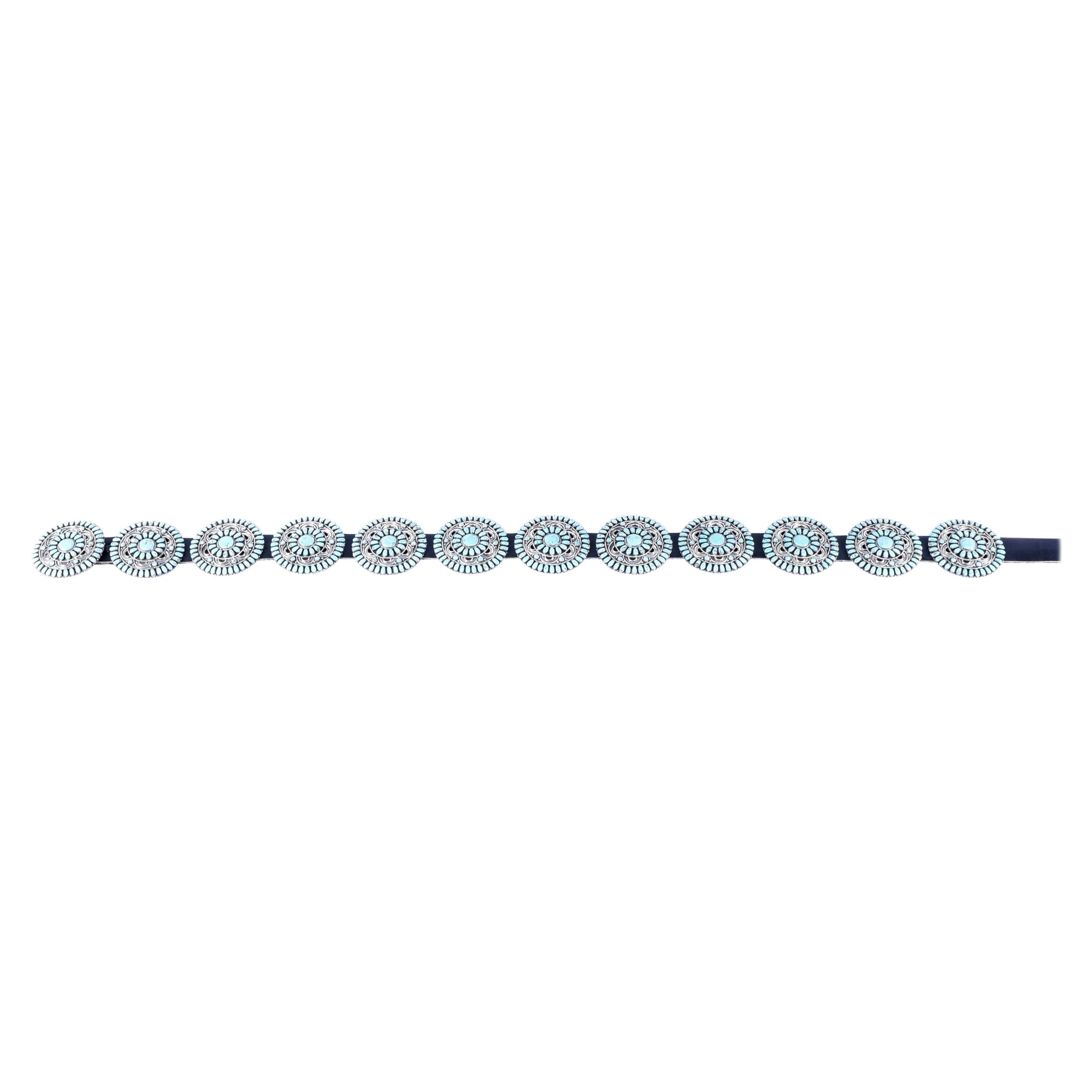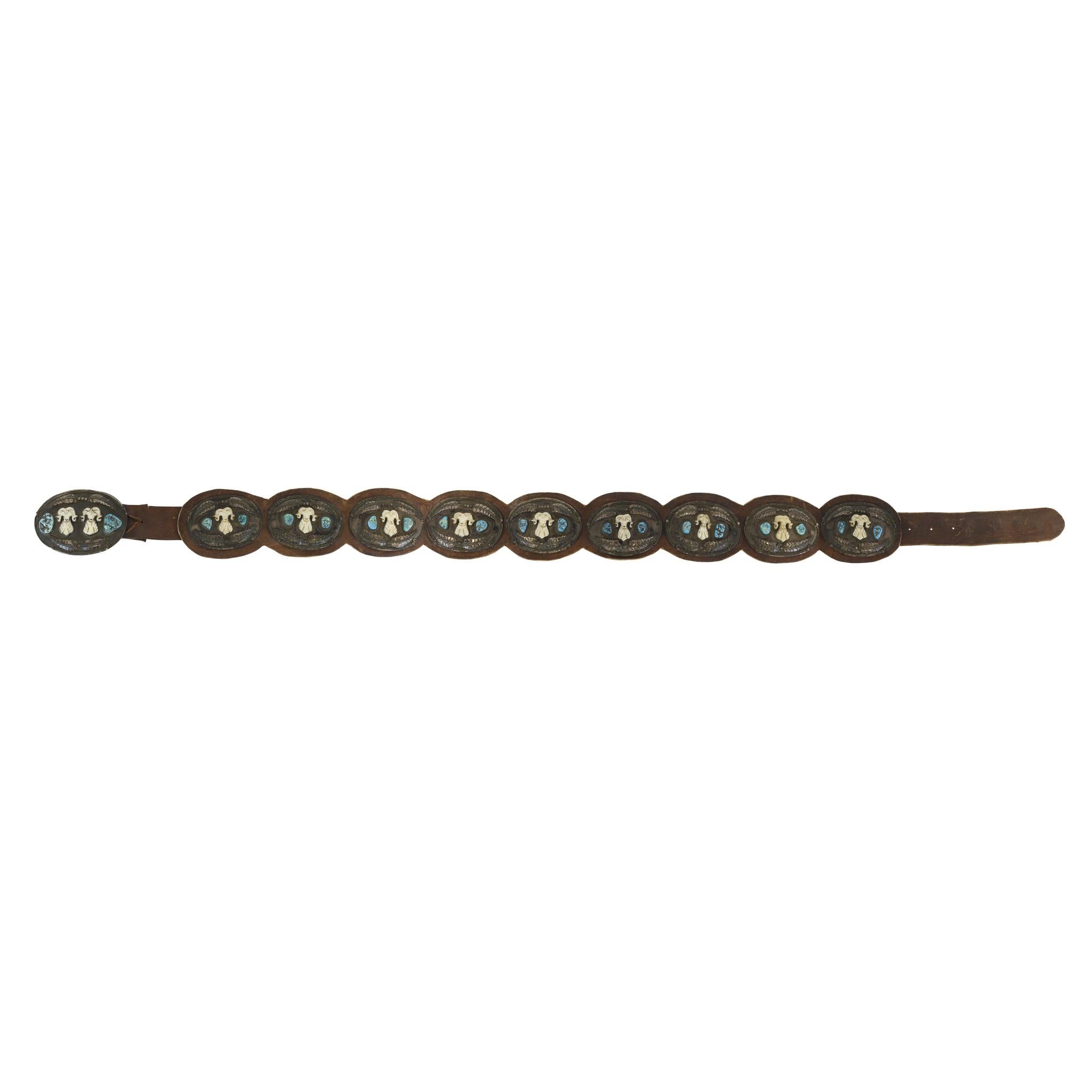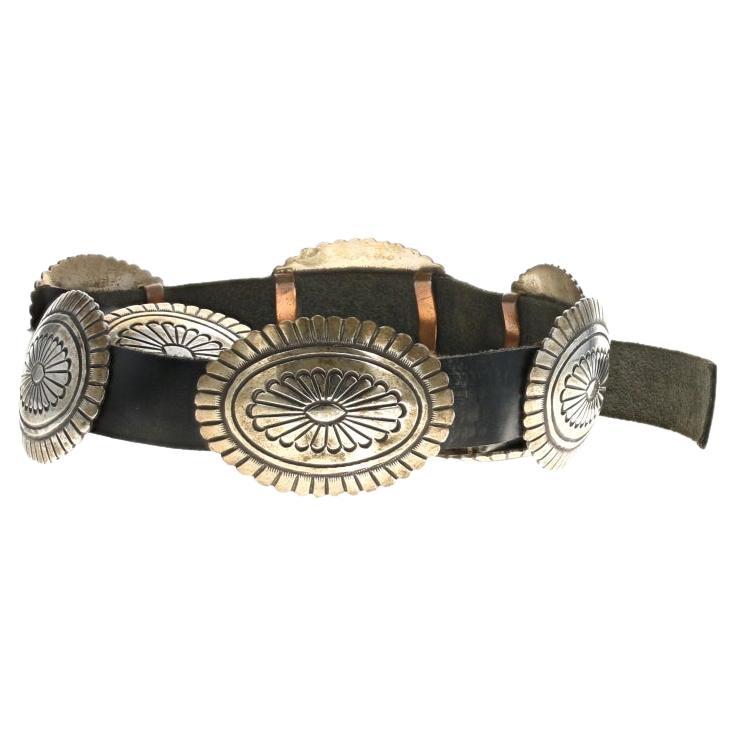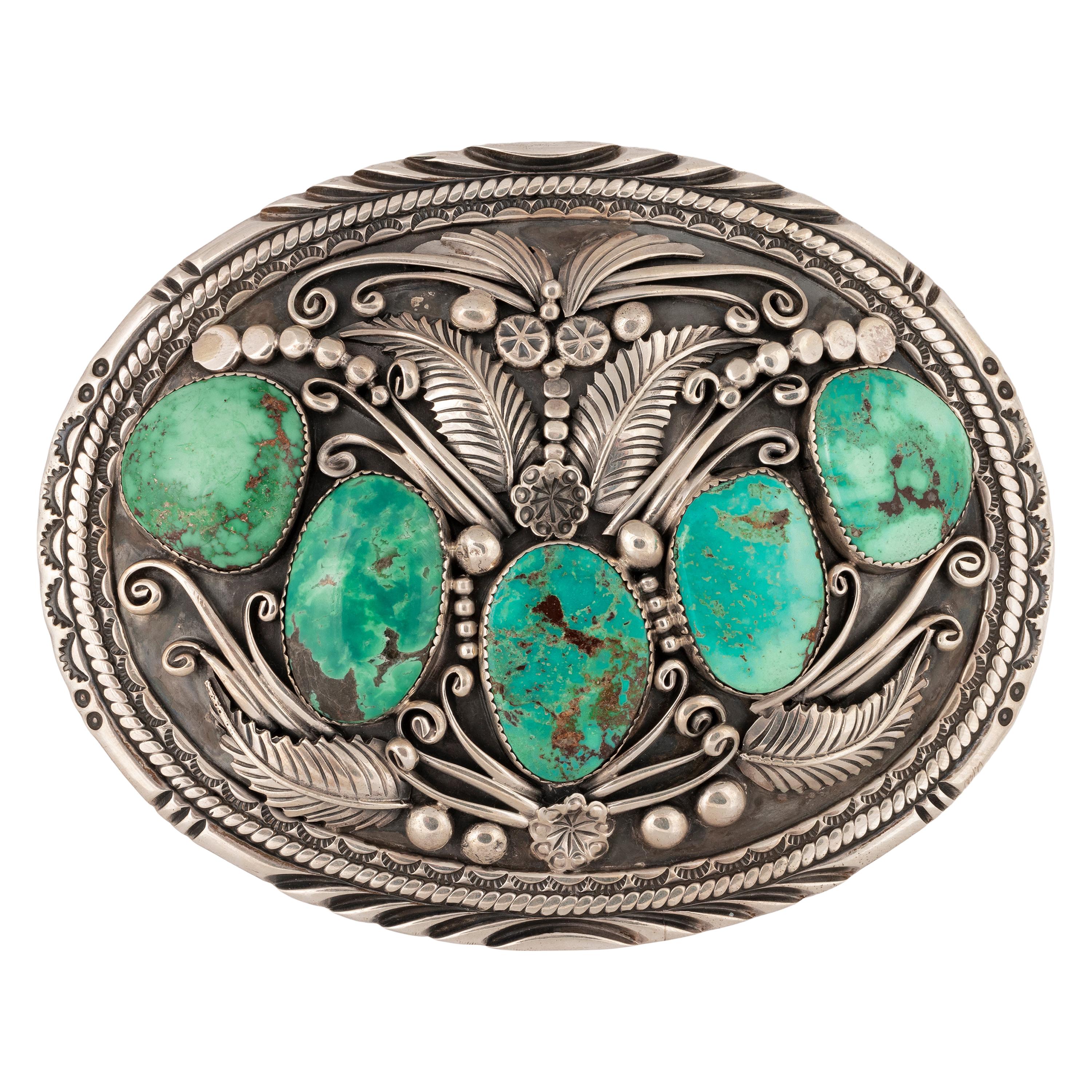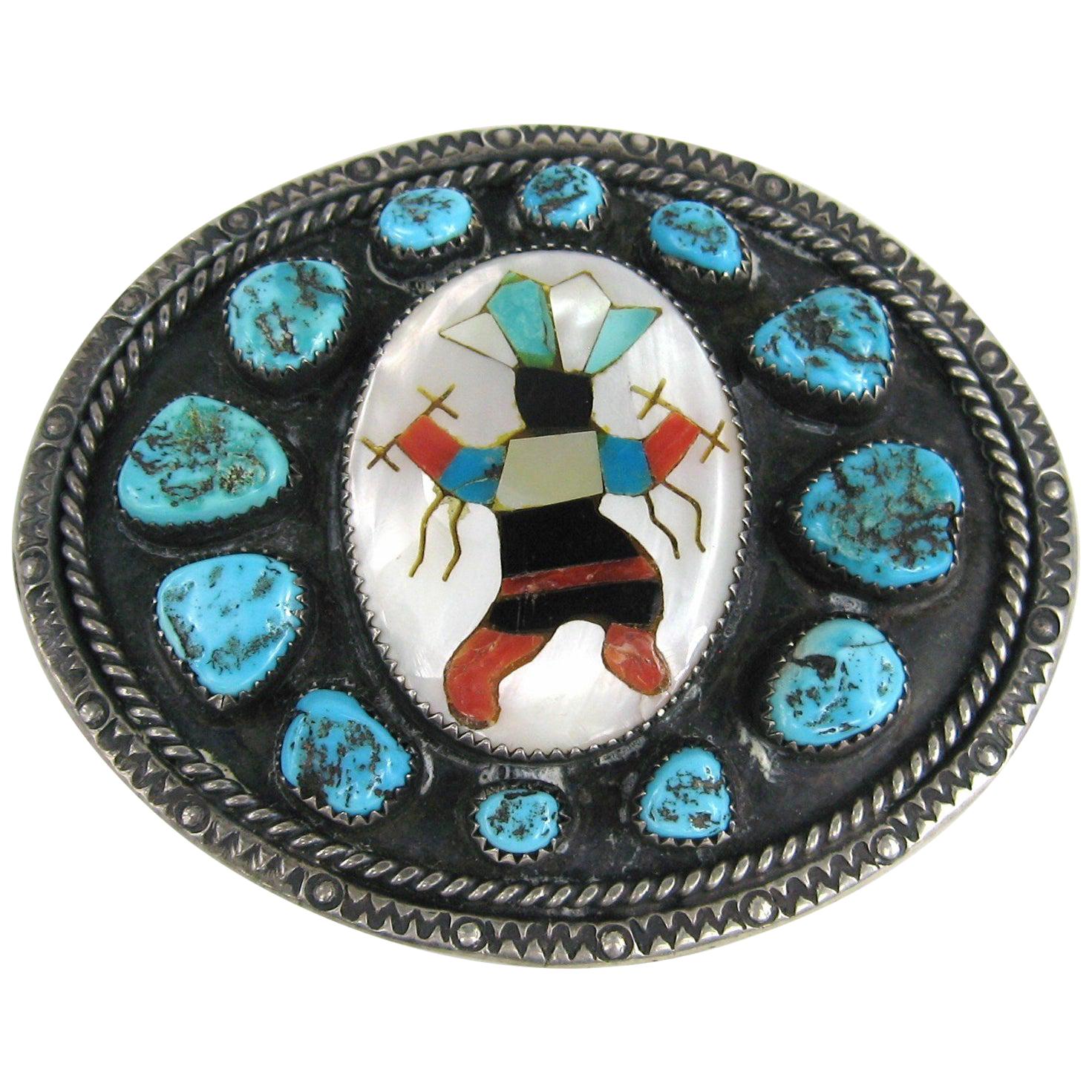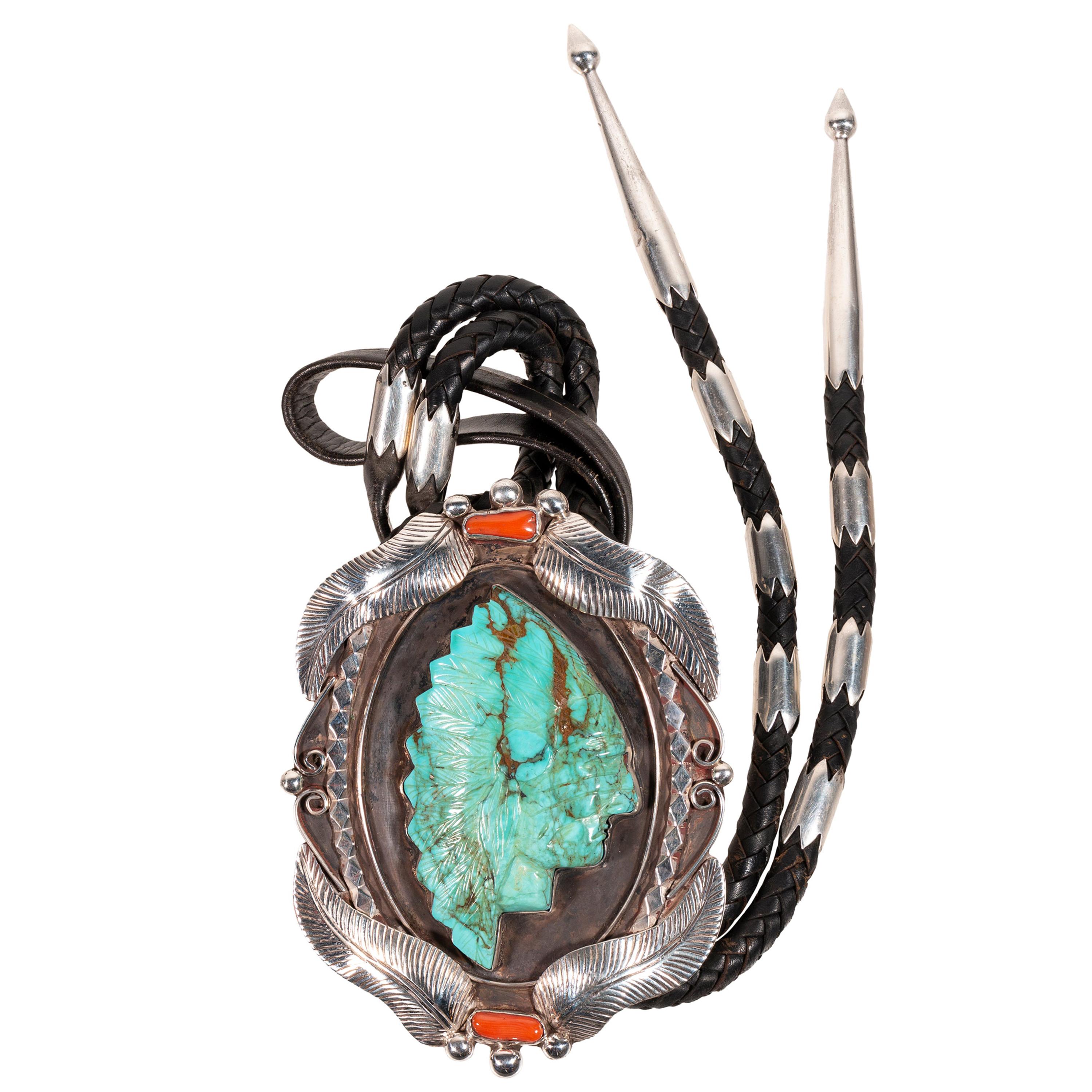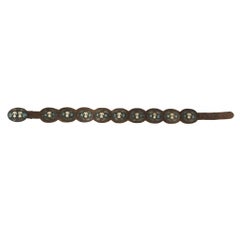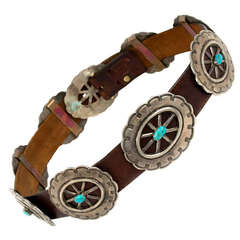
A Navajo turquoise and hammered wagon-wheel concho belt
View Similar Items
1 of 4
A Navajo turquoise and hammered wagon-wheel concho belt
About the Item
- Metal:
- Stone:
- Dimensions:Width: 2.5 in (63.5 mm)Length: 38.5 in (977.9 mm)
- Place of Origin:
- Period:
- Date of Manufacture:c. 1940
- Condition:
- Seller Location:Salt Lake City, UT
- Reference Number:1stDibs: LU552189436
You May Also Like
- Navajo Turquoise Concho BeltBy NavajoLocated in Coeur d Alene, IDNavajo concho belt with rectangular turquoise slabs, surrounded by small stones. Signed RS. The turquoise is from the Kingman Mine in Arizona. Marked ster...Category
Vintage 1950s American Native American More Jewelry
MaterialsTurquoise, Sterling Silver
- Navajo Needlepoint Turquoise Concho BeltBy NavajoLocated in Coeur d Alene, IDSigned LMB. Marked sterling; 11 conchos total. PERIOD: After 1950 ORIGIN: Navajo, Southwest SIZE: Total Belt Length 62 1/2" Leather; conchos 2 1/4"D The word “concho” sometimes spelled “concha”, comes from the Spanish word meaning shell. Some of the first “conchos” were made of melted silver dollars and resembled a shell. Concho belts reportedly began appearing in Navajo country in the late 1860s. Other Native Americans including Zuni and Hopi also made traditional concho belts before long. Concho belts can cost into the thousands of dollars depending upon the craftsmanship, amount of silver, rarity of turquoise and stones used. Belts in the upper end of the price scales are usually made before the turn of the century. Buyers should deal with reputable dealers as many fakes and look-a-likes exist. A well-made belt with age to it will fetch a bigger premium and hold its value better. The earliest concho belts are now referred to as “First Phase” belts. This style of belt was made before Native silversmith had learned much about soldering. The conchos were hammered out from melted coins, cut, and filed into shape, engraved and a diamond shape slot was cut out of the middle of the concho, with a bar left across the center of the diamond shaped slot for the leather loop. Conchos that required no soldering are generally thought to be made from 1860-1880. Second phase conchos were done 1890-1900s in which silversmith began to solder. Third phase conchos is when you start to see the “butterfly” or “bow” appear between conchos and the use of turquoise as an adornment. A butterfly (bow) is a smaller concho in between bigger conchos. A belt with butterflies and sometimes turquoise would be from the early 1900s – 1930s. The timelines may slightly differentiate depending upon who you ask. Natives first had concho belts for personal use only, but around the turn of the last century, tourist demand had kicked in and a new outlet emerged. belts & buckles jewelry silver belts conchos navajo needlepoint southwest turquoise...Category
Vintage 1950s American Native American More Jewelry
MaterialsTurquoise, Sterling Silver
- Navajo Walrus Ivory and Turquoise Concho BeltBy NavajoLocated in Coeur d Alene, IDCarved ivory bighorns with Blue Kingman Mine turquoise. Wonderful patina. Original leather; nine conchos total. Signed A.J.M. PERIOD: After 1950 ORIGIN: Navajo, Southwest SIZE: Total belt length 56"; buckle 3 1/2" x 5"; conchos 3" x 4" The word “concho” sometimes spelled “concha”, comes from the Spanish word meaning shell. Some of the first “conchos” were made of melted silver dollars and resembled a shell. Concho belts reportedly began appearing in Navajo country in the late 1860s. Other Native Americans including Zuni and Hopi also made traditional concho belts before long. Concho belts can cost into the thousands of dollars depending upon the craftsmanship, amount of silver, rarity of turquoise and stones used. Belts in the upper end of the price scales are usually made before the turn of the century. Buyers should deal with reputable dealers as many fakes and look-a-likes exist. A well-made belt with age to it will fetch a bigger premium and hold its value better. The earliest concho belts are now referred to as “First Phase” belts. This style of belt was made before Native silversmith had learned much about soldering. The conchos were hammered out from melted coins, cut, and filed into shape, engraved and a diamond shape slot was cut out of the middle of the concho, with a bar left across the center of the diamond shaped slot for the leather loop. Conchos that required no soldering are generally thought to be made from 1860-1880. Second phase conchos were done 1890-1900s in which silversmith began to solder. Third phase conchos is when you start to see the “butterfly” or “bow” appear between conchos and the use of turquoise as an adornment. A butterfly (bow) is a smaller concho in between bigger conchos. A belt with butterflies...Category
Vintage 1950s American Native American More Jewelry
MaterialsTurquoise, Sterling Silver
- Navajo Coral Concho BeltBy NavajoLocated in Coeur d Alene, IDNavajo sterling concho belt with coral nuggets, beads and rope surround. 11 conchos 2 1/2" with larger buckle 3" x 2 1/2" on black leather belt. Trunk pie...Category
Vintage 1950s American Native American More Jewelry
MaterialsCoral, Sterling Silver
$7,000 - Calvin Maloney Navajo Concho Belt, Sterling Silver Native AmericanLocated in Greensboro, NCThis Navajo belt would make a wonderful addition to a collection of First Nations art. Crafted by Calvin Maloney in sterling silver, the belt feature...Category
Late 20th Century Unknown More Jewelry
MaterialsSterling Silver
- Navajo Turquoise, Coral and Bear Claw Belt BuckleBy NavajoLocated in Coeur d Alene, IDNavbajo Kingman turquoise and bear claw bracelet with small nugget of red coral. Stones and claw set in sterling silver surrounded by leaves, scrolls and bea...Category
Vintage 1980s American Native American More Jewelry
MaterialsTurquoise, Coral, Sterling Silver
Recently Viewed
View AllMore Ways To Browse
Navajo Concho
Vintage Sterling Conchos
Vintage Sterling Silver Conchos
Brown Concho Belt
Pocket Watches For Mens Antique
St Christophers Medal Gold
Tiffany Sterling Silver Pen
Pearl Hair Comb
Cartier Vermeil Belt
Tiffany Sterling Pen
Victorian Silver Hat Pins
Tiffany Sterling Silver Pens
14k Albert Watch
Lorgnette Silver
Tiffany And Co Tie Clip
Spinner Charm
Antique Tortoise Shell Hair Combs
Antique Tortoise Shell Hair Comb

